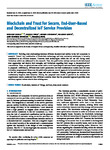Blockchain and Trust for Secure, End-User-Based and Decentralized IoT Service Provision
| dc.contributor.author | Shala, Besfort | |
| dc.contributor.author | Trick, U | |
| dc.contributor.author | Lehmann, A | |
| dc.contributor.author | Ghita, B | |
| dc.contributor.author | Shiaeles, S | |
| dc.date.accessioned | 2021-05-18T12:11:43Z | |
| dc.date.available | 2021-05-18T12:11:43Z | |
| dc.date.issued | 2020-06-29 | |
| dc.identifier.issn | 2169-3536 | |
| dc.identifier.issn | 2169-3536 | |
| dc.identifier.uri | http://hdl.handle.net/10026.1/17142 | |
| dc.description.abstract |
Building trust relationships between different decentralized entities in the IoT ecosystem is essential. Hereof, the combination of blockchain technology and trust evaluation techniques is recently considered as an efficient measure. However, both technologies within the IoT are still facing some limitations which are addressed in this research. First, this publication reviews various blockchain-based trust approaches and depicts their strengths and limitations regarding their usage in decentralized IoT communities. Then, an optimized trust model with a multi-layer adaptive and trust-based weighting system is proposed. Additionally, different trust metric parameters and their mathematical models used for trust evaluation are presented. Moreover, this publication presents a novel approach for incentivization processes in the IoT marketplace using control loops and smart contracts. Thereby, participants are motivated to continuously improve their behavior. Finally, the proposed trust model is proved to be reliable. The experimental results conducted from different scenarios show that the presented approach provides more resiliency against various attacks than existing ones. | |
| dc.format.extent | 119961-119979 | |
| dc.language.iso | en | |
| dc.publisher | Institute of Electrical and Electronics Engineers (IEEE) | |
| dc.subject | Blockchain | |
| dc.subject | Internet of Things | |
| dc.subject | services | |
| dc.subject | trust | |
| dc.subject | smart contract | |
| dc.title | Blockchain and Trust for Secure, End-User-Based and Decentralized IoT Service Provision | |
| dc.type | journal-article | |
| dc.type | Journal Article | |
| plymouth.author-url | https://www.webofscience.com/api/gateway?GWVersion=2&SrcApp=PARTNER_APP&SrcAuth=LinksAMR&KeyUT=WOS:000551986400001&DestLinkType=FullRecord&DestApp=ALL_WOS&UsrCustomerID=11bb513d99f797142bcfeffcc58ea008 | |
| plymouth.volume | 8 | |
| plymouth.publication-status | Published | |
| plymouth.journal | IEEE Access | |
| dc.identifier.doi | 10.1109/access.2020.3005541 | |
| plymouth.organisational-group | /Plymouth | |
| plymouth.organisational-group | /Plymouth/Faculty of Science and Engineering | |
| plymouth.organisational-group | /Plymouth/Faculty of Science and Engineering/School of Engineering, Computing and Mathematics | |
| plymouth.organisational-group | /Plymouth/REF 2021 Researchers by UoA | |
| plymouth.organisational-group | /Plymouth/REF 2021 Researchers by UoA/UoA11 Computer Science and Informatics | |
| plymouth.organisational-group | /Plymouth/Users by role | |
| plymouth.organisational-group | /Plymouth/Users by role/Academics | |
| dcterms.dateAccepted | 2020-06-23 | |
| dc.rights.embargodate | 2021-6-24 | |
| dc.identifier.eissn | 2169-3536 | |
| dc.rights.embargoperiod | Not known | |
| rioxxterms.versionofrecord | 10.1109/access.2020.3005541 | |
| rioxxterms.licenseref.uri | http://www.rioxx.net/licenses/all-rights-reserved | |
| rioxxterms.licenseref.startdate | 2020-06-29 | |
| rioxxterms.type | Journal Article/Review |


